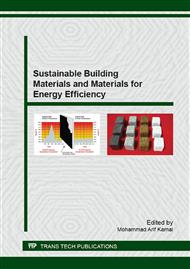p.1
p.13
p.21
p.29
p.38
p.51
p.71
p.82
Numerical Simulation of Thermal Comfort Performance in a Room with Different Insulating Materials Using Computational Fluid Dynamics
Abstract:
Numerical simulation studies are carried out for improvement of energy efficiency in a room by with different thermal insulating materials using computational fluid dynamics (CFD). The study considered various building insulating materials (BIM’s) such as: (a) Expanded Polystyrene (EPS) (b) Fiber Glass (Resin bonded (RB)-Glass wool) (c) Polyurethane Foam (PUF) and (d) Cement Plaster (CP) along with composite bricklayer combination. A multi-physical 3D model room of size 2.6 m × 2.6 m × 2.6 m is created to analyze the performance of different insulating materials using CFD simulations. The experimental data of 24 hr temperature cycle of the ambient air is used for the analysis of performance of thermal comfort inside the room with the incorporation of different thickness of the insulating materials. The thickness of insulation 0.03, 0.1, 0.2 and 0.3 m is applied on interior side of walls and roof of the building. The study performed with different grid sensitiveness for coarse, medium and fine meshes for the improvement in the accuracy of the results. The fine grid mesh analysis is chosen to carry the further studies to compare the insulated and non-insulated condition for the thermal behavior inside the room. The result shows that the thermal conductivity and heat capacity of insulated walls are very important to be taken into account for carrying out detailed thermal analysis of buildings. The studies are carried out using commercial CFD tool of ANSYS CFX 15.0. The results of comparison shows that it is possible to maintain needed thermal comfort conditions in the room while reducing the total energy consumptions at the same time by appropriate use of BIM’s.
Info:
Periodical:
Pages:
29-37
Citation:
Online since:
July 2015
Authors:
Price:
Сopyright:
© 2015 Trans Tech Publications Ltd. All Rights Reserved
Share:
Citation:


